






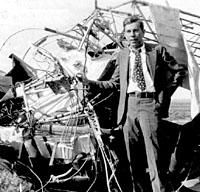

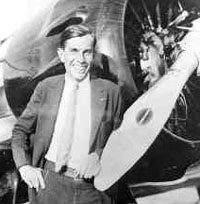


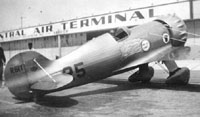
|
 As NR61Y is the only true Wedell-Williams Model 44 remaining in existence, it seemed like a good candidate for a feature on Aerofiles tracking its notable career, as well as clearing up some gray areas about racing colors and events.
Jimmy and Roscoe
By Charley Humphrey Roscoe Turner actually owned two Wedell-Williams 44 racers. The first one, NR54Y, was flown on its test flight by Jimmy Wedell and seemed to perform very well. When he took it up again later that day for a high-speed low pass, aileron buzz caused a wing to flutter, then snap the flying wires and fold the wing. Wedell had designed the plane to have independent aileron control, so he held full aileron against the roll while pitching up for altitude and bleeding off speed, then pushed himself out of the cockpit. His 'chute opened fully just as he touched down at the end of the field! Back in 1931, Roscoe Turner was flying a Lockheed Air Express on tours promoting Gilmore Red Lion Oil (and Roscoe Turner, of course). It is the opinion of this writer that Frank Hawks' gadding about the country in the Texaco Mystery Ship likely prompted Roscoe into thinking he needed to move a little quicker in order to remain in the forefront of aviation. He needed headlines and records and flashy planes in order to tout the glories of all that Gilmore oil burned while flying starlets of the talkies era out to Catalina Island, Hot Springs, and other popular 1930s getaways. So, in one of those strange quirks of Fate, one day an amazingly unphotogenic man landed at Burbank and parked his Model 44 in the shade of Turner's wing. He was Jimmy Wedell, who became the raceplane designer and builder of the '30s. Say all you want about the Gee Bees, Lairds, and Severskys, only Keith Rider was able to approach Wedell when it came to longevity in racing planes. Jimmy raced his first creation in the 1930 American Cirrus Derby, and one of his ships placed in the money in the 1939 Thompson Trophy Race. If you feed in some college-level math, that's ten years! Turner and Wedell struck up an initial friendship and an agreement that would prove mutually profitable. Roscoe had mentioned that he wanted to have a 300-mph racer built, but that the designers he had talked with said they weren't interested. Jimmy, on the other hand, was very interested and believed he could design and build a 300-plus ship. 1932 = NR61Y was born in Patterson, Louisiana, that year. She was a pretty girl with a sleek, smooth NACA cowl housing her chesty Pratt & Whitney R-985. Roscoe flew her to California for the start of the 1932 Bendix race in an unpainted condition. His mechanic and right hand, Don Young, not only had to build her, but paint her in a dark hangar literally just prior to racetime. The colors she wore for that racing season were the most famous of all the Wedell paint schemes—silvery creme with red and black trim—and race #121. Nicknamed in a burst of creativity as the "Gilmore Red Lion," Turner flew her to third place behind Jim Haizlip in the Wedell-Williams #92 and Jimmy Wedell in #44. Poor Roscoe placed third in the Thompson Trophy, as well, trailing Jimmy Doolittle in the Gee Bee R-1 and Jimmy Wedell in #44—he could not overcome Fate's bias towards all things Jimmy as the legendary "Three Jimmys" of 1932 proved unbeatable. However, things got better the next year! 1933 = After spending a morning ducking a process server at Floyd Bennett Field in New York, Turner, in disguise as a mechanic, managed to get into the cockpit and fly to first place in the Bendix — but only sixth in the Thompson. NR61Y wore colors that Harpo Marx would have been proud of. For the Nationals, she sported a whitewashed #2 atop the sparkly gold paint of the fuselage, while the wings retained the creme, red, and black Gilmore scheme. She also had a new P&W R-1340 hidden beneath a smooth, tight fitting cowl. Also, Gilmore Oil had been chucked and 20th Century Fox was the new sponsor, hustling their movie The Bowery (which, naturally, had nothing to do with airplanes or racing). By the time the Chicago races came along, Fox had been replaced by Macmillan Oil, H.T. sparkplugs, Bendix, and Smith propellers, and the plane became the first "Ring-Free Special." 1934 = Turner once more upgraded the engine to the little-known R-1690 Hornet, for which 61Y had a smooth NACA cowl, as well as a bumped cowl for another Pratt & Whitney, and another sponsor change—the Heinz pickle works logo and race #57 was emblazoned on her sides. 61Y had turned all-gold by then only because the over-worked and under-appreciated Don Young finally found time to finish painting after building a new engine mount and cowlings. 1935 = 61Y was primarily sponsored by MacMillan Oil Co, and the Ring Free logo was placed where the previous race number was located, in a circle under the cockpit window, with number 57 in black halfway down the length of the fuselage. When it came to the Bendix Race that year, Benny Howard in Mr Mulligan beat Turner across the finish line by 23.5 seconds! The press, of course, immediately pointed out that Roscoe had posed for pictures 30 seconds too long. During the Thompson his supercharger impeller went to pieces and exploded, perforating the cowling, accessory section, oil lines, etc. Trailing thick black smoke, Roscoe managed to see well enough out of an oil covered windshield (that rose only 5 inches above the fuselage) to make his normal three- bounce landing to a standing ovation, while Howard, ignored by all but timers and judges, won the Thompson. Roscoe is quoted as responding to a reporter's condolences by saying that walking away from potential disaster was luck enough. 1936 = The Colorful Colonel put his Wedell-Williams out of the running when he bumped into the desert near Holbrook, Arizona, breaking off the fuselage completely just aft of the cockpit. After getting in a pissing match with Larry Brown, who was foolishly pressing Roscoe for money for the rebuild, Turner hired Matty Laird to finish the project, which resulted in a shortened fuselage, new wheel fairings, and some other subtle changes. 1937 = Turner moved out of the picture to fly his Laird-Turner Racer and Joe Mackay moved in, flying 61Y as race #25, continuing to place in the money until the end of her career with retirement after the 1939 NARs at the advent of World War 2. NR61Y still exists, on display at the Crawford Museum in Cleveland, Ohio—where Don Young used to be the curator—and the gold paint still sparkles as it did during her heyday in the Golden Age of Air Racing. If you want to see her, it costs a nickel, if you want to touch, it's a dollar. |
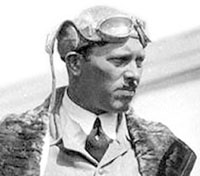

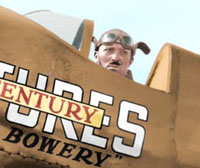

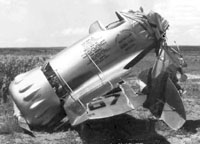
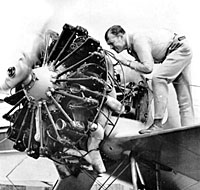


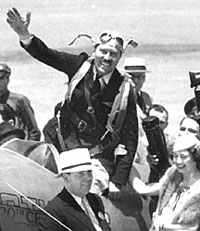

|
